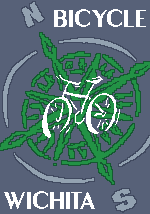 Angry Jack's Tube Tree, out behind the Bicycle X-Change's West Douglas location. Click to enlarge. Image via Riders of Rohan.
Angry Jack's Tube Tree, out behind the Bicycle X-Change's West Douglas location. Click to enlarge. Image via Riders of Rohan.A round-up of things:
I've been instructed not to apologize for my silences here, so I'll just say that work and other obligations have kept me from here. I am looking forward to our rescheduled Readers' Rides for this weekend, though, and I hope we have the combination of other folks and decent weather. On Saturday the 15th at 9:00 a.m., we'll meet on the south side of Kellogg at Armour; on Sunday the 16th at 1:00, we'll meet at the softball fields at Plainview Park.
Though I wasn't able to do the Readers' Ride this weekend, I was out errand-running on my bike Saturday morning: my first chilly-weather ride, about 10 miles in all. Despite the stiff north wind (which, because of my route, fortunately was something I didn't have to contend with for very long) and a temperature in the mid-30s, I was dressed warmly, if ridiculously, enough (only my toes got a little cold). I was wearing "civilian" clothes, though: a warm but not breathable lightweight jacket; jeans; heavy gloves; a wide elastic band over the ears, tennis shoes. It worked--I stayed warm--but I won no style points, and I was distracted at times by the bulkiness of it all. Maybe Santa Claus will bring me some more-appropriate cold-weather gear . . .
On Election Day I walked to my polling place (I had considered riding, but I didn't know if there would be bike racks; as it turned out, there weren't). At any rate, at the intersection of Central and Wichita (Wichita runs between the county courthouse and the county jail, in case you were wondering), a Cornejo Construction crew was busily at work digging up not only a good bit of sidewalk but also a lot of soil. As I wondered what they were up to, I suddenly remembered the recent news of the new downtown bike path. So: it's good to see that work has indeed begun on that project.
Via local and loyal reader Mark comes some welcome news for touring cyclists:
The United States is on a path to creating what could become the largest official bicycle route network in the world, thanks to the approval of a new plan by America's leading authority on national route designations. The American Association of State Highway and Transportation Officials (AASHTO) has just approved a National Corridor Plan laying out the framework and guidelines for the development of this system.You can find further information, including criteria for routes and links to other trail sites, here.
The plan identifies corridors connecting America's urban, rural, and suburban areas. The corridors cover well over 50,000 miles, which, if transformed into routes along roads and trails, would create the largest official bicycle route network in any country or on any continent. By comparison, the planned Euro-Velo network in Europe is projected to be 60,000 kilometers or 36,000 miles.
Mark was also kind enough to send along a link to a map showing proposed routes: (pdf file). The astute among you will note that Wichita is included on one of these routes.
You may remember that last month I noted that an Obama administration would be keenly interested in developing alternative-transportation networks. News of the development of this bicycle route network, along with the new administration's transportation policy priorities, is all welcome news to cyclists who use their bikes as more than recreation.
I'm surprised that this thread didn't attract any comments. If you're wary about ratting on your fellow cyclists, you can always post anonymously.
Quote of the week? From the Springfield [MO] News-Leader (via Carbon Trace): "Our study showed people were going fast enough to warrant a higher speed."--Earl Newman, Springfield city traffic engineer. You should read the article, but the upshot is that the city is raising speed limits on some streets for no apparent reason other than the fact that people are already driving faster anyway. Along the lines of this reasoning: one of the local television stations recently had a story in which a reporter confronted drivers who were ignoring school zone speed limits. So, maybe we shouldn't have school zones? Many in Wichita are so small (often about half a block) that the temptation is indeed strong to simply ignore them. Or what about those pesky stop lights? And those folks that drive over 100 mph on the Kansas Turnpike--should we accommodate them as well?
Human nature being what it is, there are folks who push limits, whatever those limits might be. Their default setting for driving speeds is, Whatever the sign says plus 5 (or 10 or . . . ) mph. My former mother-in-law is such a person; her motto is, "You know how fast you need to go." There's no way to safely accommodate such people and protect the safety of those of us who have better control over our ids. Some laws are meant to inconvenience us--for our own good, and that of others. Besides: in these days of greater awareness of fuel consumption and the near-certainty that gas prices will rise, driving slower--enforced through current or reduced speed limits--is an excellent way to reduce fuel consumption.
Mr. Newman is, I'm certain, a fine American. But his thinking about speed limits (not to mention its implications for pedestrians and cyclists) seems born of an earlier America of cheap gas and bikes on sidewalks. Those days are receding from memory. It would be to our mutual benefit if our city planners, you know, planned--for a coming future and not for a past that no longer serves us well.















No comments:
Post a Comment